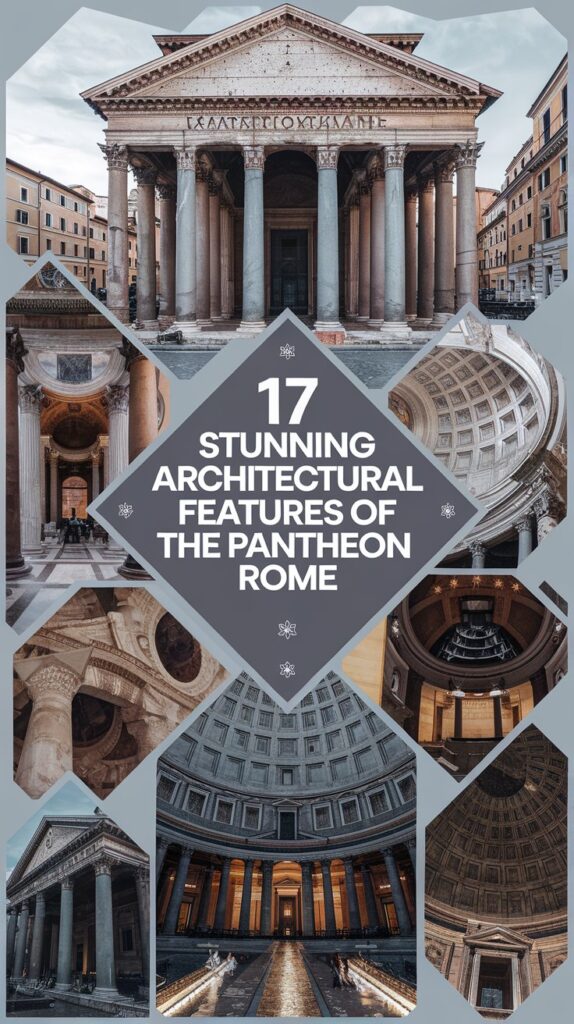17 Stunning Architectural Features of the Pantheon Rome That Will Leave You in Awe!
17 Stunning Architectural Features of the Pantheon Rome That Will Leave You in Awe!
The Pantheon in Rome is one of the greatest architectural marvels of antiquity. With its timeless design and engineering brilliance, this ancient structure continues to inspire architects and historians.
Let’s explore 17 of the Pantheon’s most stunning architectural features that make it a masterpiece.
1. The Iconic Dome: The Largest Unreinforced Concrete Dome in the World
The Pantheon’s dome is a testament to Roman engineering. Spanning 43.3 meters, it remains the largest unreinforced concrete dome ever built. The dome’s interior design symbolizes the heavens, a fitting metaphor for the temple’s divine purpose.
2. The Oculus: A Natural Light Source
At the center of the dome is the oculus, a circular opening that measures 8.2 meters in diameter. This feature provides natural light, creating an ethereal atmosphere inside. The oculus also reduces the dome’s weight, a clever structural solution.
3. Perfect Proportions: A Testament to Roman Precision
💥🎁 Christmas & Year-End Deals On Amazon !
Don't miss out on the best discounts and top-rated products available right now!
🛒 Shop Now and Save Big Today!*As an Amazon Associate, I earn from qualifying purchases.
The Pantheon’s proportions are meticulously calculated. The height from the floor to the oculus matches the dome’s diameter, forming a perfect sphere. This symmetry symbolizes the harmony between heaven and earth.
4. The Portico: A Grand Entrance
The Pantheon’s portico features 16 massive Corinthian columns made of Egyptian granite. These columns support an imposing pediment, creating a grand entrance that sets the tone for the building’s magnificence.
5. Corinthian Columns: Graceful and Strong
Each column in the portico is over 11.8 meters tall and weighs around 60 tons. Transported from Egypt, these columns demonstrate the Romans’ logistical prowess and their penchant for incorporating elements from conquered territories.
6. The Rotunda: A Circular Sanctuary
The Pantheon’s rotunda is a vast, circular space that showcases Roman ingenuity in designing large open interiors. Its walls are nearly 6 meters thick, supporting the immense weight of the dome.
7. Innovative Concrete Mix: Lightweight and Durable
The Romans used a special lightweight concrete made of volcanic ash (pozzolana) for the dome. This innovative material reduced the dome’s weight while enhancing its durability, ensuring its survival for nearly two millennia.
8. The Coffered Ceiling: Beauty and Functionality
💥🎁 Christmas & Year-End Deals On Amazon !
Don't miss out on the best discounts and top-rated products available right now!
🛒 Shop Now and Save Big Today!*As an Amazon Associate, I earn from qualifying purchases.
The dome’s interior features coffered panels arranged in concentric circles. These coffers reduce the weight of the dome while adding visual depth and elegance to its design.
9. The Oculus Drainage System
Rainwater entering through the oculus is efficiently drained through a slightly convex floor and hidden drainage channels, a subtle yet brilliant design feature.
10. The Pantheon’s Facade: Harmonious Design
The facade combines a triangular pediment with classical elements like columns and entablatures. The inscription honoring Marcus Agrippa pays homage to the building’s origins.
11. The Marble Floors: A Geometric Masterpiece
Inside, the Pantheon’s marble floor features intricate geometric patterns. Crafted from imported materials, the floors exemplify the Romans’ dedication to artistry and detail.
12. Hidden Buttresses: Invisible Support
The Pantheon’s walls contain concealed arches and buttresses that distribute the weight of the dome evenly. These hidden features reflect the sophistication of Roman structural engineering.
13. The Niche System: Functional and Aesthetic
💥🎁 Christmas & Year-End Deals On Amazon !
Don't miss out on the best discounts and top-rated products available right now!
🛒 Shop Now and Save Big Today!*As an Amazon Associate, I earn from qualifying purchases.
The Pantheon’s interior features a series of niches originally designed to hold statues of Roman gods. These niches enhance the building’s symmetry and functionality.
14. The Bronze Doors: Ancient Craftsmanship
The massive bronze doors at the entrance weigh approximately 20 tons. These doors are original and are among the few ancient Roman bronze structures to survive intact.
15. Adaptability of Design: From Temple to Church
Originally built as a temple for Roman gods, the Pantheon was later converted into a Christian church. This adaptability has contributed to its preservation through changing times.
16. Roman Concrete: A Mystery Unveiled
The Pantheon’s longevity is partly due to the unique Roman concrete used in its construction. Modern researchers continue to study this material to understand its unparalleled resilience.
17. The Timeless Legacy: An Inspiration for Generations
From the U.S. Capitol to St. Peter’s Basilica, the Pantheon’s design has influenced countless iconic buildings. Its blend of form, function, and symbolism remains a benchmark in architecture.
Conclusion
💥🎁 Christmas & Year-End Deals On Amazon !
Don't miss out on the best discounts and top-rated products available right now!
🛒 Shop Now and Save Big Today!*As an Amazon Associate, I earn from qualifying purchases.
The Pantheon is more than an ancient structure; it’s a living testament to human creativity and ingenuity. Each feature, from its awe-inspiring dome to its intricate details, tells a story of Roman ambition and excellence. A visit to the Pantheon is not just a journey through history but an encounter with timeless beauty.
Which feature of the Pantheon impresses you the most? Share your thoughts below!



